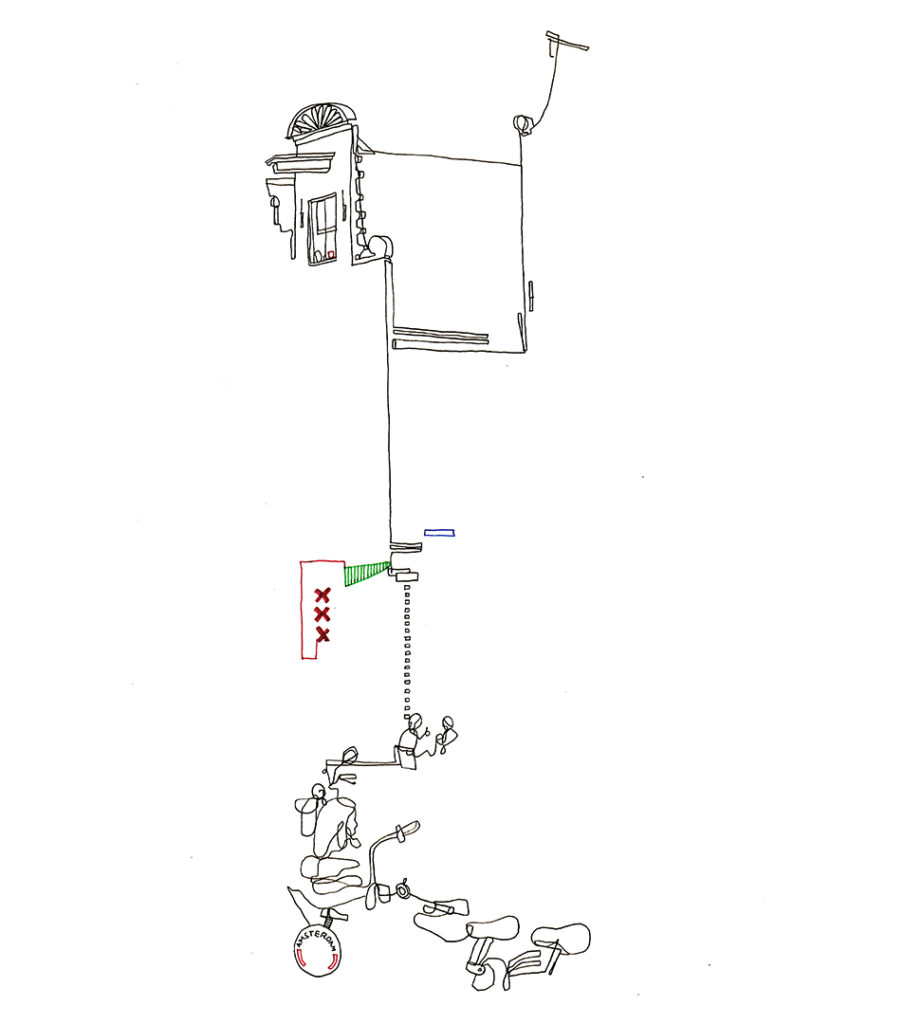Richard Briggs tape drawings
Richard has been using tape to explore and express spatial qualities in cities in the past 3 years. Initial the use of tape was a response in how he could legally place artworks in public spaces without damaging any property. Unlike tagging, or other forms of graffiti, the use of painter’s tape allows the artworks to be placed quickly, and if required easily removed.
The first drawing was done as an experiment in 2017 in a laneway in Sydney, with the key question being how long it would last on the wall before it’s taken down, or added to, or tagged over. It lasted over 466 days, before weathering got the better of the tape and it disintegrated. The drawing was very abstract, and wasn’t of anything in particular, but here was the opportunity, to take lines from the sketchpad to the walls, floors of the streets and the objects that occupy them. The only way to do this was to continue the work that Richard encourages throughout all his artwork practice, which is to simplify what he sees. The tape thickness is similar to using a large wide paint brush, which works well with this aspiration, and meant that the scale of the work could be expanded and could become quite large. The city became Richard’s sketch book.

In the following 3 years, tape drawings have been completed by Richard in numerous places around the world, from Porto, to Manchester, to Phomn Penh to Amsterdam. The temporal nature of this application means that once that the tape drawing is completed, it becomes the property of the city. As soon as the artist has documented it and walked away, it’s in the public’s hands. It always been an aspiration for these tape drawings to start a conversation with passers by or other street artists, and for layer upon layer to be added so that they almost become invisible, much in the way that street art operates today, with paste ups, and tagging being overlying each other.
Aside from the opportunity to make the drawings very simple, and to work out a way to do this without losing what they are supposed to represent, they respond and work with the urban context. They can be placed on doors, wall or street objects, always working alongside components that exist such as door handles, drainpipes, edges of walls, junctions of walls and floors and paving joins. The simpler they are the more abstract they become, making the viewer stop and look hard to see what they represent, or just to take them as abstract pieces of art in unusual places.

In terms of process, they are usually very quick and spontaneous, much in the same way a tagger would work. Sometimes a small thumb sketch is done, to work out what the key message is, but in most cases it’s an instinctive process but knowing when to stop, like with all of Richard’s drawing work is critical. This can be the difference between too much detail being added meaning that the keys lines and shapes are lost and is just becomes a mass of blue tape.
Using this method also embraces the art for all approach. No real skill is required to apply the tape to the surface, only imagination and a desire to communicate an idea about public spaces, people and places. It can be a great way to bring people together and Richard has run workshops where using tape has allowed groups to gather and start to think more about their surroundings. In that tape art is an art for all.
Richard Briggs is a practising artist and British registered architect based in Sydney Australia, and through his drawings he aims to provoke and inform discussion on the built environment. His simple line drawings explore the hidden gems in our cities encouraging the viewer, visitor, and the inhabitant to look at the streets in a different way. From the finer details to large expansive lines of a city skyline, his drawings evolve into patterns that form spaces and urban quirks which aim to convey a sense of character. Importantly, they also aim to tell numerous stories about a particular place, it’s people and are community and are site specific.

Briggs has been exploring and drawing streets for the past 18 years and was a workshop instructor at the Urban Sketchers Symposium held in Manchester in 2016, and Amsterdam in 2019. He has taught drawing on location in private practise, public forums and co-runs a course at University of New South Wales in Sydney, which helps built environment students explore cities using urban sketching as a tool.

He also works on large scale artworks, ranging from wall drawings in public spaces, to using tape to explore and express spatial qualities in the city streets. These simple line based drawings are totally scalable and can work on a laneway door or a 6m high wall on the side of a building. Briggs also uses a community led process to inform various artwork concepts. This ensures artworks have deep and meaningful interpretations about place, people, culture, history and the future. This people centred approach also allows artworks subjects to develop through conversations, which over time can lead to a greater understanding of how to connect an artwork to place and the future needs of a community.
Book references:
Line and Surface by eltono
Urban Maps: instruments of narrative and interpretation in the city by Richard Brook and Nick Dunn (especially chapter 5)
The journal of public space editor Luisa Bravo 2018 volume 2 number 2
Tactical Urbanism by Mike Lydon and Antony Garcia
ESTE TRABALHO É FINANCIADO POR FUNDOS NACIONAIS ATRAVÉS DA FCT – FUNDAÇÃO PARA A CIÊNCIA E A TECNOLOGIA, I.P., NO ÂMBITO DO PROJETO “UIDB/04042/2020”
